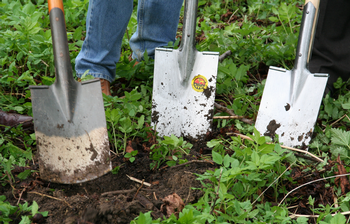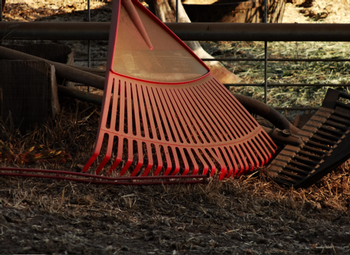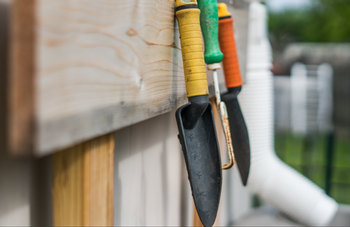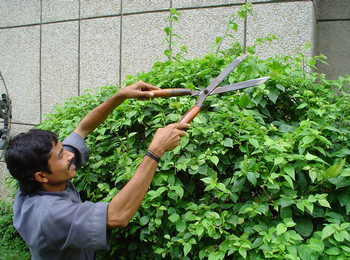Selecting and caring for garden tools
-
Hand tools are among the best examples of time-tested design and environmentally friendly technology, helping us dig, cut, move, and gather -- without causing air or noise pollution. As long as there is sunlight to work by, you can get a lot done with just a pair of gardening gloves and a few well-chosen hand tools.
Our choices for hand tools contribute as much to our success as gardeners as the plants we select for our landscapes or the amendments we add to the soil. The right tool helps you work efficiently and motivates you to complete a daunting planting project or maintenance task. The wrong tool forces you to quit early in frustration, pain, or fatigue. While the right tool will give its owner many years of reliable service, the wrong tool will collect cobwebs in a dark corner of the garage.
When you’re making a purchasing decision about any hand tool, ergonomic considerations should factor in prominently. While most high-quality tools are designed with the comfort and safety of the user in mind, gardeners come in many shapes and sizes, and not every tool fits every gardener. As you compare your options, measure the overall value of a tool by the quality of each of these factors: construction, comfort, and cost.
Three Cs of tool purchases: construction, comfort, cost
While material considerations are largely a matter of preference, educate yourself on the options and treatments for metal components (carbon-steel blades, forged Chromium steel heads, heat-treating, anti-rust coatings) and moving parts. Some people prefer the lightweight durability of fiberglass handles on rakes, shovels, and hoes, while others opt for wood. Usually, dried hardwoods such as white ash or beech are used for handle construction. If wood is your preference, make sure the surface is sealed or coated, with no raised spots that could turn into splinters with wear. In addition to material composition, consider how the product is constructed. Evaluate the joins, welds, and attachment points that are used in the construction of the tool, especially at stress points such as the head-to-handle connection on shovels. Look for blades, rake heads, or digging forks composed of a single piece of metal rather than joined pieces.
When mulling over the cost-to-quality aspect of your purchasing decision, consider how often you will use the tool. Hand pruners are a good place to spend your money on quality, as you are likely to pick them up and use them at least once every time you garden. Some tools, such as shovels, help you to accomplish a variety of garden tasks while others, such as the dandelion weeder, are designed to do just one thing well. If you don’t spend a lot of time removing deep-diving, tap-rooted weeds in your yard but regularly have lots of Japanese maple leaves to rake, you might opt for that less expensive dandelion weeder and put the money you save into a high-quality rake. Photo: pxhere
Photo: pxhereRakes and digging tools
When considering rakes, shovels, and trowels, pick them up and think about how they fit your body with respect to your grip, height, and reach. Test the weight, and remember to factor in the weight of the materials (leaves, soil, gravel) you will be moving with the tool. Evaluate the length of the handle and determine whether it is appropriate for your body height. Photo: pxhere
Photo: pxhereTo get maximum leverage out of straight-handled digging and raking tools, aim for a handle length that falls between your elbows and chest. Also consider the option of a D-handled tool, which provides an alternative grip option and allows you to apply force from the handle end. On shovels, don’t forget that half of the action of digging involves placing your foot on the rolled edge of the head to push it into the surface of the soil. Make sure the step (the part you tread on) is adequately sized for your foot and is designed so that you can comfortably dig without slipping or losing balance.
 Photo: pxhere
Photo: pxhere
Trowels and hand forks are often cast in one piece, out of lightweight, rust-resistant aluminum alloy. Some have handles that are dip-coated in a vinyl material to provide a secure grip; others use foam padding attached with adhesive. Pick up these tools and test the heaviness and balance of the head to the handle.
Cutting toolsHere is another area where weight should be a consideration. If the tool is one that you’ll raise overhead, will you tire lifting it? In addition, look for shock-absorbing bumpers to cushion or deflect the impact of the blades closing (particularly with hedge trimmers). Look for padding on handles, which provides added grip security as well as comfort. Some pruners and loppers are designed with gears or ratcheting action to provide more leverage at the cut. This can be a real asset for gardeners with limited grip strength, as long as the gear mechanism is constructed to last. Photo: pxhere
Photo: pxhereTest out the open-and-close action of the tool and pass on ones with a sticky or awkward cutting action, since over time this repetitive movement could induce fatigue and stress injuries in your hands or upper body. Other marks of quality for cutting tools are bolted-on handles and replaceable blades that you can sharpen between uses.
 Loppers are handy tools for bigger jobs. Photo: Wikimedia Commons
Loppers are handy tools for bigger jobs. Photo: Wikimedia Commons
Also think about the practical application of a cutting tool as it relates to your particular garden site. Does the pole pruner you are considering offer an adequate extension length for your needs? The lopper with 1-1/2-inch cutting capacity might be less expensive, but if the more expensive one offers a 2-inch cutting capacity, the difference in price could be worth it because you can cut a wider variety of materials with it.
Take good care of your tools.After use, hose off metal parts or use a stiff-bristled brush to remove dirt and plant material. Oiling the metal parts of digging and cutting tools will help prevent rust, and an occasional application of linseed oil preserves wood handles. The best maintenance habit to get into for the long life of your hand tools is to store them indoors, protected from the elements.
Original article by Jennifer Kinion for the Marin IJ
Edited for the Leaflet by Marie Narlock





